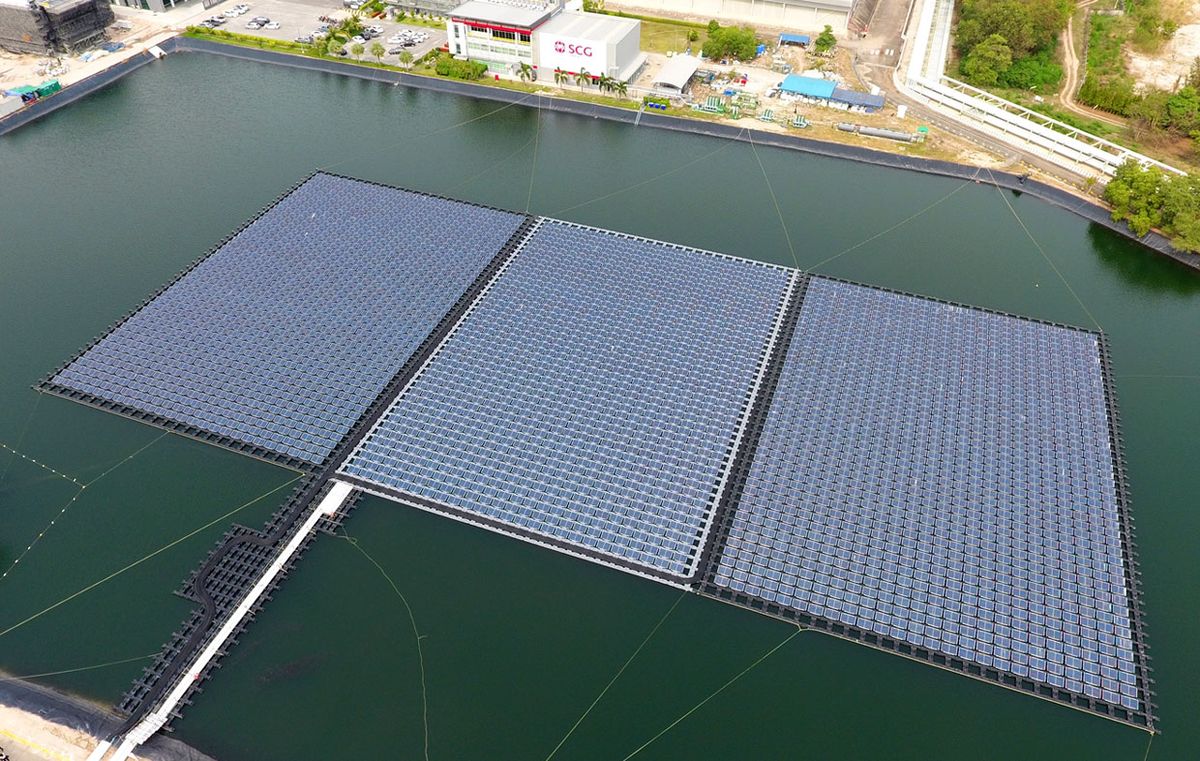Solar farms take up land, which is especially precious in areas with dense populations—and those areas need renewable power most. To solve this paradox, populous countries short on land have started to turn to solar farms that float on reservoirs and dams. Of the world’s 1.1 gigawatts of floating solar capacity, 450 megawatts exists in China, Japan, India, and South Korea.
Thailand now wants in, and an unlikely player is vying to get a big share of that market. Thailand’s Siam Cement Group (SCG), one of Southeast Asia’s largest building-material companies, has developed floating solar modules that it will build, install, and maintain. As the only large Thai company making floating panels, it hopes to land contracts to build at least some of the 1 GW of floating solar capacity that state-run Electricity Generating Authority of Thailand (EGAT) plans to install across eight dams over the next two decades.
EGAT announced in January that installation of the first project, a 45-MW farm at the Sirindhorn Dam on the country’s eastern border, would begin in April, with four others following soon after. But the utility still hasn’t picked a supplier. “Right now, EGAT is in a competitive bidding process, and we’re trying to be one of the winners,” says Chatree Kettong, energy development manager at SCG Chemicals Co., a subsidiary of Siam Cement Group.
Floating solar is part of the petrochemical producer’s goals to diversify its business, Kettong says. SCG makes the mounting platforms for its floating solar farms from durable and recyclable high-density polyethylene. The pontoons should last 50 years, twice the expected life-span of the encapsulated, water-resistant silicon solar panels that SCG buys from various suppliers. Each module generates 100 kilowatts, and they can be easily bolted together. Their design is also more streamlined, he says: A 1-MW floating plant takes 10 percent less space than competitors’ plants.
The company has already installed 5 MW of floating solar projects in eastern and southern Thailand, mostly at factories. And the company is starting to sell to clients in other Southeast Asian countries.
The French company Ciel & Terre could give the Thai firm some stiff competition. The firm, which pioneered the floating solar concept in 2006, already has projects under way in Thailand. It opened a floating solar-equipment-manufacturing facility there last year that customizes a product for the country, where a major requirement is low cost. “Pontoons are the more expensive part of floating solar, and Ciel & Terre has a monopoly on this,” says Jordan Macknick, the lead energy-water-land analyst at the United States’ National Renewable Energy Laboratory.
But plastics are SCG’s specialty, and its ability to produce pontoons in-house should keep costs down. In fact, the company has teamed up with EGAT to conduct R&D for floating buoy materials at a pilot plant in the Tha Thung Na Dam, according to the Bangkok Post.
Thailand today gets 12 percent of its energy from renewables and hydropower. The government aims to increase the country’s renewables share to 37 percent by 2036, with solar providing 17 GW. Half of that, or 6 percent of the country’s total power, could in principle come from floating solar farms, according to the Thai law firm Pugnatorius.
Floating solar is attractive in Thailand, and the country’s several hydropower plants offer ideal staging waters. “Hydropower and floating solar make a lot of sense together because the grid infrastructure is already built,” Macknick says. Hydropower can balance out solar’s variable output, he adds, and “floating systems on reservoirs could reduce evaporation from those reservoirs, which means more fuel for hydropower systems.”
Solar farms are also easier to set afloat on water than to install on land, which can require clearing, excavation, and grading, says Kettong. The two remaining challenges facing floating solar in the country are the complicated permit process (which can take three to six months) and building credibility. “This is a new product, and a new concept, for Thai companies,” he says.
This article appears in the March 2019 print issue as “Thailand Experiments With Floating Solar Plants.”
